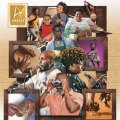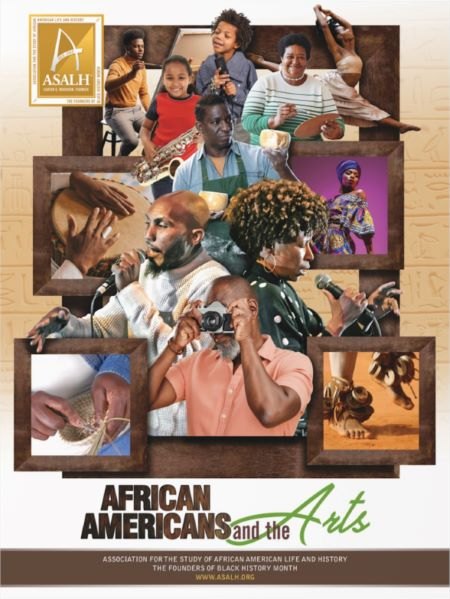Happening at the library
Celebrating African Americans and the Arts

01.31.24
Every February, the United States acknowledges the history and achievements of African Americans with Black History Month.
The Des Plaines Public Library plays its part in this annual observance by featuring Black History Month displays containing media from and about Black artists on both the third and fourth floor.
Here is a brief overview of how this month-long observance came to be and explain this year’s theme as decided by the ASALH.
A curated list of books, films, and music related to the theme is included, as well.
Why was February chosen as Black History Month?

Woodson chose this particular week in order to honor two Americans who played a prominent role in the advancement of African American people: Abraham Lincoln and Frederick Douglas, whose birthdays are respectively the 12th and 14th of February.
The shift from being only a week-long observance to one that lasted the whole month prominently began in the 60s, a decade in which Black educators and students across the country used their influence to bring greater awareness to Black history.
Their collective efforts would prove fruitful when, in 1975, President Gerald Ford officially recognized February as Black History Month.
You can read the full origins of Black History Month on the ASALH’s official website.
What is the ASALH?
ASALH stands for the Association for the Study of African-American Life and History.
According to their website, the ASALH was established by Dr. Carter G. Woodson on September 9, 1915 in order to help teach the public about Black history.
Every February, the ASALH decides on a new theme for Black History Month in order to explore a new facet of African American culture.
2024’s Black History Theme is African Americans and the Arts
This year, the ASALH announced that the theme of 2024’s Black History Month will be African Americans and the Arts.
As part of the announcement, the ASALH highlighted a number of artistic forms and cultural movements in which African American influence was and is prominent, including the Black Renaissance of the 20s and 30s, music such as jazz and hip-hop, and even a contemporary subgenre of speculative fiction called Afrofuturism.
If you want to experience the many rich and diverse forms Black art can take, please consider checking out any of the following recommended media listed below.
Want More?
- Make sure to check out the Black History Month displays on your next visit to the library
- Explore all the online Black History Month resources and streaming content available in DPPL's online collections.
- Read what we have recommended in years past HERE, HERE, and HERE.
NONFICTION
Music Is History
by Ahmir “Questlove” Thompson
Focusing on the years 1971 to the present, Questlove finds the hidden connections in the American tapestry, whether investigating how the blaxploitation era reshaped Black identity or considering the way disco took an assembly-line approach to Black genius.
ARTBOOK
Kehinde Wiley: A Republic
“The works presented in Kehinde Wiley: A New Republic raise questions about race, gender, and the politics of representation by portraying contemporary African American men and women using the conventions of traditional European portraiture. The exhibition includes an overview of the artist's prolific fourteen-year career and features sixty paintings and sculptures.” – Brooklyn Museum website
FICTION
The Love Songs of W.E.B. Du Bois
By Honoree Fanonne Jeffers
To come to terms with who she is and what she wants, Ailey, the daughter of an accomplished doctor and a strict school teacher, embarks on a journey through her family's past, helping her embrace her full heritage, which is the story of the Black experience in itself.
FILM
One Night in Miami…
Directed by Regina King
A fictional account of one amazing night where icons Muhammad Ali, Malcolm X, Sam Cooke, and Jim Brown gathered, discussing their roles in the Civil Rights Movement and cultural turmoil of the '60s.
MUSIC
To Pimp a Butterfly
By Kendrick Lamar
Prominently a hip-hop album, Kendrick Lamar incorporates a diverse selection of music styles associated with African-American music history, such as jazz and funk. Lamar’s lyricism and social commentary are unparalleled, exploring themes of racial discrimination, depression, and materialism. Content warning: this album contains explicit lyrics.
POETRY
African-American Poetry: 250 Years of Struggle and Song
Across a turbulent history, Black poets created a rich and multifaceted tradition that has been both a reckoning with American realities and an imaginative response to them. One of the great American art forms, African American poetry encompasses many kinds of verse: formal, experimental, vernacular, lyric, and protest.
DOCUMENTARY
Summer of Soul (...Or, When the Revolution Could Not Be Televised)
Directed by Ahmir “Questlove” Thompson
A powerful and transporting documentary--part music film, part historical record--created around an epic event that celebrated Black history, culture and fashion. Over the course of six weeks in the summer of 1969, just one hundred miles south of Woodstock, The Harlem Cultural Festival was filmed in Mount Morris Park (now Marcus Garvey Park). The footage was largely forgotten--until now.
MEMOIR
Finding Me
By Viola Davis
“In my book, you will meet a little girl named Viola who ran from her past until she made a life-changing decision to stop running forever. This is my story, from a crumbling apartment in Central Falls, Rhode Island, to the stage in New York City, and beyond. This is the path I took to finding my purpose but also my voice in a world that didn't always see me.” – Viola Davis